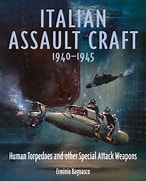
Italian Assault Craft 1940-1945 – Human Torpedoes and other Special Attack Weapons. By Erminio Bagnsaco. Seaforth Publishing, Barnsley 2023.
Reviewed by John Mortimer
The author Erminio Bagnasco is a well known former Italian Navy officer who has published several books on the Italian Navy, including “The Littorio Class” and “Italian Battleships”. He also co-founded and has been editor since 1993 of Storia Militare, Italy’s leading military journal.
Italian Assault Craft is divided into two parts. Part 1 discusses the origins, development and use of assault craft. It commences with the birth of assault craft in Italy during the First World War. The first and most important of these was the Motobarca Armata Silurante (MAS boat), “Grillo” type jumping boats and mignatta self propelled torpedoes. The latter two were designed to attack Austrian warships in their protected harbours. Their most notable success was the sinking of the Austrian battleship Viribus Unitis on 1 November 1918 in Pola Harbour by a self propelled torpedo S.2 ‘mignatta’. A chronology of the operations during both major wars is then provided in some detail. Of relevance to the Royal Australian Navy, mention is made of the sinking of the Italian submarine Gondar by HMAS Stuart. At the time Gondar was deploying three self propelled torpedoes intended for an attack on shipping at Alexandria.
This is followed by an assessment of Italian projects and experiments in the 1920s and 1930s, as well as development and use of Italian assault craft between 1940 and 1943, and Armistice and Italian co-belligerencies 1943 to 1945. The use of explosive motorboats by Israel in 1948 and assault craft used by other navies during the Second World War, especially the Royal, German and Japanese navies, is also discussed. Part 2 comprises a description of Italian Assault craft , which is quite comprehensive and detailed. It is categorised under the following headings: Surface craft, underwater craft, assault divers, their means of deployment, and infrastructure.
This book provides an excellent discussion of the development and employment of Italian assault craft and the major role they played in Italian naval operations , in their infancy during the First World War, but more importantly during the Second World War where their elite performance achieved many spectacular results. The most notable being an attack on Alexandria Harbour which badly damaged the British Battleships Queen Elizabeth and Valiant, and the sinking of the British Cruiser York at Suda.
Employment of this type of forces remains as relevant today as it was during the previous century. The recent employment of special forces by Ukraine to attack Russian naval forces in the Black Sea has also seen some spectacular success.
In many respects this book provides a more balanced presentation of Italian naval forces, especially during the Second World War, where its naval personnel showed considerable ingenuity, gallantry and professionalism. This aspect of naval warfare is frequently overlooked in favour of more glamorous things like nuclear submarines, major surface combatants, aircraft and missiles. It is readily apparent that the Australia’s clearance diving force has a major role to play in Australia’s future maritime defence. I highly recommend this book.



